Nerium
Nerium oleander /ˈnɪəriəm ˈoʊliːændər/,[1] most commonly known as oleander or nerium, is a shrub or small tree belonging to subfamily Apocynoideae of the dogbane family Apocynaceae and is cultivated worldwide in temperate and subtropical areas as an ornamental and landscaping plant. It is the only species currently classified in the genus Nerium. It is so widely cultivated that no precise region of origin has been identified, though it is usually associated with the Mediterranean Basin.
| Nerium | |
|---|---|
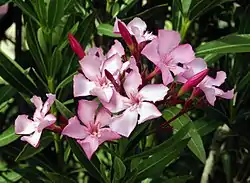 | |
| Nerium oleander flower and leaves | |
| Scientific classification | |
| Kingdom: | Plantae |
| Clade: | Tracheophytes |
| Clade: | Angiosperms |
| Clade: | Eudicots |
| Clade: | Asterids |
| Order: | Gentianales |
| Family: | Apocynaceae |
| Subfamily: | Apocynoideae |
| Tribe: | Nerieae |
| Genus: | Nerium L. |
| Species: | N. oleander |
| Binomial name | |
| Nerium oleander L. | |
| Synonyms | |
|
Numerous, see text | |
Nerium grows to 2–6 m (7–20 ft) tall. It is most commonly grown in its natural shrub form, but can be trained into a small tree with a single trunk. It is tolerant to both drought and inundation, but not to prolonged frost. White, pink or red five-lobed flowers grow in clusters year-round, peaking during the summer. The fruit is a long narrow pair of follicles, which splits open at maturity to release numerous downy seeds.
Several compounds in nerium exhibit toxicity, and it has historically been considered a poisonous plant. However, its bitterness renders it unpalatable to humans and most animals, so poisoning cases are rare and the general risk for human mortality is low. Ingestion of larger amounts may cause nausea, vomiting, excess salivation, abdominal pain, bloody diarrhea and irregular heart rhythm. Prolonged contact with sap may cause skin irritation, eye inflammation and dermatitis.
Etymology
The origins of the taxonomic name Nerium oleander, first assigned by Linnaeus in 1753, are disputed.[2] The genus name Nerium is the Latinized form of the Ancient Greek name for the plant nẽrion (νήριον), which is in turn derived from the Greek for water, nẽros (νηρός), because of the natural habitat of the oleander along rivers and streams.
The word oleander appears as far back as the first century AD, when the Greek physician Pedanius Dioscorides cited it as one of the terms used by the Romans for the plant.[3] Merriam-Webster believes the word is a Medieval Latin corruption of Late Latin names for the plant: arodandrum or lorandrum, or more plausibly rhododendron (another Ancient Greek name for the plant), with the addition of olea because of the superficial resemblance to the olive tree (Olea europea)[Note 1][4][5] Another theory posited is that oleander is the Latinized form of a Greek compound noun: οllyo (ὀλλύω) 'I kill', and the Greek noun for man, aner, genitive andros (ἀνήρ, ἀνδρός).[6] ascribed to oleander's toxicity to humans.
The etymological association of oleander with the bay laurel has continued into the modern day: in France the plant is known as "laurier rose",[7] while the Spanish term, "Adelfa", is the descendant of the original Ancient Greek name for both the bay laurel and the oleander, daphne, which subsequently passed into Arabic usage and thence to Spain.[8]
The ancient city of Volubilis in Morocco may have taken its name from the Berber name alili or oualilt for the flower.[9]
Description

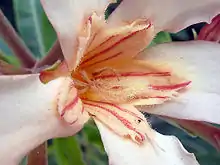
Oleander grows to 2–6 m (6.6–19.7 ft) tall, with erect stems that splay outward as they mature; first-year stems have a glaucous bloom, while mature stems have a grayish bark. The leaves are in pairs or whorls of three, thick and leathery, dark-green, narrow lanceolate, 5–21 cm (2.0–8.3 in) long and 1–3.5 cm (0.39–1.38 in) broad, and with an entire margin filled with minute reticulate venation web typical of eudicots. Leaves are light green and very glossy when young, before maturing to a dull dark green.
The flowers grow in clusters at the end of each branch; they are white, pink to red,[Note 2] 2.5–5 cm (0.98–1.97 in) diameter, with a deeply 5-lobed fringed corolla round the central corolla tube. They are often, but not always, sweet-scented.[Note 3] The fruit is a long narrow pair of follicles 5–23 cm (2.0–9.1 in) long, which splits open at maturity to release numerous downy seeds.
Taxonomy
Nerium oleander is the only species currently classified in the genus Nerium. It belongs to (and gives its name to) the small tribe Nerieae of subfamily Apocynoideae of the dogbane family Apocynaceae. The genera most closely-related thus include the equally ornamental (and equally toxic) Adenium G.Don and Strophanthus DC. - both of which contain (like Oleander) potent cardiac glycosides that have led to their use as arrow poisons in Africa. [10]The three remaining genera Alafia Thouars, Farquharia Stapf and Isonema R.Br. are less well-known in cultivation.
Synonymy
The plant has been described under a wide variety of names that are today considered its synonyms:[11][12]
- Oleander Medik.
- Nerion Tourn. ex St.-Lag.
- Nerion oleandrum St.-Lag.
- Nerium carneum Dum.Cours.
- Nerium flavescens Spin
- Nerium floridum Salisb.
- Nerium grandiflorum Desf.
- Nerium indicum Mill.
- Nerium japonicum Gentil
- Nerium kotschyi Boiss.
- Nerium latifolium Mill.
- Nerium lauriforme Lam.
- Nerium luteum Nois. ex Steud.
- Nerium madonii M.Vincent
- Nerium mascatense A.DC.
- Nerium odoratissimum Wender.
- Nerium odoratum Lam.
- Nerium odorum Aiton
- Nerium splendens Paxton
- Nerium thyrsiflorum Paxton
- Nerium verecundum Salisb.
- Oleander indica (Mill.) Medik.
- Oleander vulgaris Medik.
Habitat and range
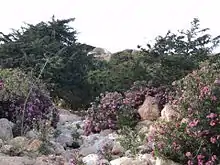
Nerium oleander is either native or naturalized to a broad area spanning from Northwest Africa and Iberian peninsula eastward through the Mediterranean region, to the Arabian peninsula, southern Asia, and as far east as Yunnan in southern parts of China.[13][14][15][16] It typically occurs around stream beds in river valleys, where it can alternatively tolerate long seasons of drought and inundation from winter rains. Nerium oleander is planted in many subtropical and tropical areas of the world.
On the East Coast of the US, it grows as far north as Virginia Beach, Virginia, while in California and Texas miles of oleander shrubs are planted on median strips.[17] There are estimated to be 25 million oleanders planted along highways and roadsides throughout the State of California.[18] Because of its durability, oleander was planted prolifically on Galveston Island in Texas after the disastrous Hurricane of 1900. They are so prolific that Galveston is known as the 'Oleander City'; an annual oleander festival is hosted every spring.[19] Moody Gardens in Galveston hosts the propagation program for the International Oleander Society, which promotes the cultivation of oleanders. New varieties are hybridized and grown on the Moody Gardens grounds, encompassing every named variety.[20]
Beyond the traditional Mediterranean and subtropical range of oleander, the plant can also be cultivated in mild oceanic climates with the appropriate precautions. It is grown without protection in southern England and can reach great sizes in London and to a lesser extent in Paris[21] due to the urban heat island effect.[22][23][24] This is also the case with North American cities in the Pacific Northwest like Portland,[25] Seattle, and Vancouver. Plants may suffer damage or die back in such marginal climates during severe winter cold but will rebound from the roots.
Ecology
Some invertebrates are known to be unaffected by oleander toxins, and feed on the plants. Caterpillars of the polka-dot wasp moth (Syntomeida epilais) feed specifically on oleanders and survive by eating only the pulp surrounding the leaf-veins, avoiding the fibers. Larvae of the common crow butterfly (Euploea core) and oleander hawk-moth (Daphnis nerii) also feed on oleanders, and they retain or modify toxins, making them unpalatable to potential predators such as birds, but not to other invertebrates such as spiders and wasps.
The flowers require insect visits to set seed, and seem to be pollinated through a deception mechanism. The showy corolla acts as a potent advertisement to attract pollinators from a distance, but the flowers are nectarless and offer no reward to their visitors. They therefore receive very few visits, as typical of many rewardless flower species.[26][27] Fears of honey contamination with toxic oleander nectar are therefore unsubstantiated.
Leaf scorch
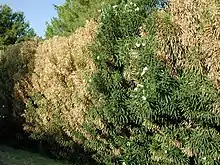
A bacterial disease known as oleander leaf scorch has become an extremely serious threat to the shrub since it was first noticed in Palm Springs, California, in 1992.[28] The disease has since decimated hundreds of thousands of shrubs mainly in Southern California, but also on a smaller scale in Arizona, Nevada and Texas.[29][30] The culprit is a bacterium called Xylella fastidiosa, which is spread via insects (the glassy-winged sharpshooter primarily) which feed on the tissue of oleanders and spread the bacteria. This inhibits the circulation of water in the tissue of the plant, causing individual branches to die until the entire plant is consumed.
Symptoms of leaf scorch infection may be slow to manifest themselves, but it becomes evident when parts of otherwise healthy oleanders begin to yellow and wither, as if scorched by heat or fire. Die-back may cease during winter dormancy, but the disease flares up in summer heat while the shrub is actively growing, which allows the bacteria to spread through the xylem of the plant. As such it can be difficult to identify at first because gardeners may mistake the symptoms for those of drought stress or nutrient deficiency.[31]
Pruning out affected parts can slow the progression of the disease but not eliminate it.[28] This malaise can continue for several years until the plant completely dies—there is no known cure.[18] The best method for preventing further spread of the disease is to prune infected oleanders to the ground immediately after the infection is noticed.
Ornamental gardening
.jpg.webp)
Oleander is a vigorous grower in warm subtropical regions, where it is extensively used as an ornamental plant in parks, along roadsides and in private gardens. It is most commonly grown in its natural shrub form, but can be trained into a small tree with a single trunk.[32] Hardy versions like white, red and pink oleander will tolerate occasional light frost down to −10 °C (14 °F),[16] though the leaves may be damaged. The toxicity of oleander renders it deer-resistant and its large size makes for a good windbreak – as such it is frequently planted as a hedge along property lines and in agricultural settings.
The plant is tolerant of poor soils, intense heat, salt spray, and sustained drought – although it will flower and grow more vigorously with regular water. Although it does not require pruning to thrive and bloom, oleander can become unruly with age and older branches tend to become gangly, with new growth emerging from the base. For this reason gardeners are advised to prune mature shrubs in the autumn to shape and induce lush new growth and flowering for the following spring.[30] Unless they wish to harvest the seeds, many gardeners choose to prune away the seedpods that form on spent flower clusters, which are a drain on energy.[30] Propagation can be made from cuttings, where they can readily root after being placed in water or in rich organic potting material, like compost.
In Mediterranean climates oleanders can be expected to bloom from April through October, with the heaviest bloom usually occurring between May and June. Free-flowering varieties like 'Petite Salmon' or 'Mont Blanc' require no period of rest and can flower continuously throughout the year if the weather remains warm.
In cold winter climates, oleander is a popular summer potted plant readily available at most nurseries. They require frequent heavy watering and fertilizing as compared to being planted in the ground, but oleander is nonetheless an ideal flowering shrub for patios and other spaces with hot sunshine. During the winter they should be moved indoors, ideally into an unheated greenhouse or basement where they can be allowed to go dormant.[32] Once they are dormant they require little light and only occasional watering. Placing them in a space with central heating and poor air flow can make them susceptible to a variety of pests – aphids, mealybugs, oleander scale, whitefly and spider mites.[33]
Colors and varieties
Oleander flowers are showy, profuse, and often fragrant, which makes them very attractive in many contexts. Over 400 cultivars have been named, with several additional flower colors not found in wild plants having been selected, including yellow, peach and salmon. Many cultivars, like 'Hawaii' or 'Turner's Carnival', are multi-colored, with brilliant striped corollas.[34] The solid whites, reds and a variety of pinks are the most common. Double flowered cultivars like 'Mrs Isadore Dyer' (deep pink), 'Mathilde Ferrier' (yellow) or 'Mont Blanc' (white) are enjoyed for their large, rose-like blooms and strong fragrance. There is also a variegated form, 'Variegata', featuring leaves striped in yellow and white.[30] Several dwarf cultivars have also been developed, offering a more compact form and size for small spaces. These include 'Little Red', 'Petite White', 'Petite Pink' and 'Petite Salmon', which grow to about 8 feet (2.4 m) at maturity.[35]
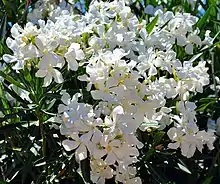
Toxicity

Oleander has historically been considered a poisonous plant because some of its compounds may exhibit toxicity, especially to animals, when consumed in large amounts. Among these compounds are oleandrin and oleandrigenin, known as cardiac glycosides, which are known to have a narrow therapeutic index and can be toxic when ingested.
Toxicity studies of animals administered oleander extract concluded that birds and rodents were observed to be relatively insensitive to oleander cardiac glycosides.[36] Other mammals, however, such as dogs and humans, are relatively sensitive to the effects of cardiac glycosides and the clinical manifestations of "glycoside intoxication".[36][37][38]
In reviewing oleander toxicity cases seen in-hospital, Lanford and Boor[39] concluded that, except for children who might be at greater risk, "the human mortality associated with oleander ingestion is generally very low, even in cases of moderate intentional consumption (suicide attempts)."[39] In 2000, a rare instance of death from oleander poisoning occurred when two toddlers adopted from a Siberian orphanage ate the leaves from a neighbor's shrub in El Segundo, California.[40] A spokesman for the Los Angeles County Coroner's office stated that it was the first instance of death connected to oleander in the county, and a toxicologist from the California Poison Control Center said it was the first instance of death he had seen recorded. Because oleander is extremely bitter, officials speculated that the toddlers had developed a condition caused by malnutrition, pica, which causes people to eat otherwise inedible material.[41]
Effects of poisoning
Ingestion of this plant can affect the gastrointestinal system, the heart, and the central nervous system. The gastrointestinal effects can consist of nausea and vomiting, excess salivation, abdominal pain, diarrhea that may contain blood, and especially in horses, colic.[15] Cardiac reactions consist of irregular heart rate, sometimes characterized by a racing heart at first that then slows to below normal further along in the reaction. Extremities may become pale and cold due to poor or irregular circulation. The effect on the central nervous system may show itself in symptoms such as drowsiness, tremors or shaking of the muscles, seizures, collapse, and even coma that can lead to death.
Oleander sap can cause skin irritations, severe eye inflammation and irritation, and allergic reactions characterized by dermatitis.[42]
Treatment
Poisoning and reactions to oleander plants are evident quickly, requiring immediate medical care in suspected or known poisonings of both humans and animals.[42] Induced vomiting and gastric lavage are protective measures to reduce absorption of the toxic compounds. Activated charcoal may also be administered to help absorb any remaining toxins.[15] Further medical attention may be required depending on the severity of the poisoning and symptoms. Temporary cardiac pacing will be required in many cases (usually for a few days) until the toxin is excreted.
Digoxin immune fab is the best way to cure an oleander poisoning if inducing vomiting has no or minimal success, although it is usually used only for life-threatening conditions due to side effects.[43]
Drying of plant materials does not eliminate the toxins. It is also hazardous for animals such as sheep, horses, cattle, and other grazing animals, with as little as 100 g being enough to kill an adult horse.[44] Plant clippings are especially dangerous to horses, as they are sweet. In July 2009, several horses were poisoned in this manner from the leaves of the plant.[45] Symptoms of a poisoned horse include severe diarrhea and abnormal heartbeat. There is a wide range of toxins and secondary compounds within oleander, and care should be taken around this plant due to its toxic nature. Different names for oleander are used around the world in different locations, so, when encountering a plant with this appearance, regardless of the name used for it, one should exercise great care and caution to avoid ingestion of any part of the plant, including its sap and dried leaves or twigs. The dried or fresh branches should not be used for spearing food, for preparing a cooking fire, or as a food skewer. Many of the oleander relatives, such as the desert rose (Adenium obesum) found in East Africa, have similar leaves and flowers and are equally toxic.
Therapeutic efficacy
Drugs derived from N. oleander have been investigated as a treatment for cancer, but have failed to demonstrate clinical utility.[46][47] According to the American Cancer Society, the trials conducted so far have produced no evidence of benefit, while they did cause adverse side effects.[48]
Cultivation history

Nerium oleander has a history of cultivation going back millennia, especially amongst the great ancient civilizations of the Mediterranean Basin. Some scholars believe it to be the rhodon (rose), also called the 'Rose of Jericho', mentioned in apocryphal writings (Ecclesiasticus XXIV, 13)[49] dating back to between 450 and 180 BC.[50][51]
The ancient Greeks had several names for the plant, including rhododaphne, nerion, rhododendron and rhodon.[50] Pliny confirmed that the Romans had no Latin word for the plant, but used the Greek terms instead.[52] Pedanius Dioscorides states in his 1st century AD pharmacopeia De Materia Medica that the Romans used the Greek rhododendron but also the Latin Oleander and Laurorosa. The Egyptians apparently called it scinphe, the North Africans rhodedaphane, and the Lucanians (a southern Italic people) icmane.[53] Both Pliny and Dioscorides stated that oleander was an effective antidote to venomous snake bites if mixed with rue and drunk.
A 2014 article in the medical journal Perspectives in Biology and Medicine posited that oleander was the substance used to induce hallucinations in the Pythia, the female priestess of Apollo, also known as the Oracle of Delphi in Ancient Greece.[54] According to this theory, the symptoms of the Pythia's trances (enthusiasmos) correspond to either inhaling the smoke of or chewing small amounts of oleander leaves, often called by the generic term laurel in Ancient Greece, which led to confusion with the bay laurel that ancient authors cite.
In his book Enquiries into Plants of circa 300 BC, Theophrastus described (among plants that affect the mind) a shrub he called onotheras, which modern editors render oleander; "the root of onotheras [oleander] administered in wine", he alleges, "makes the temper gentler and more cheerful".
The plant has a leaf like that of the almond, but smaller, and the flower is red like a rose. The plant itself (which loves hilly country) forms a large bush; the root is red and large, and, if this is dried, it gives off a fragrance like wine.
In another mention, of "wild bay" (Daphne agria), Theophrastus appears to intend the same shrub.[55]
Oleander was a very popular ornamental shrub in Roman peristyle gardens; it is one of the flora most frequently depicted on murals in Pompeii and elsewhere in Italy. These murals include the famous garden scene from the House of Livia at Prima Porta outside Rome, and those from the House of the Wedding of Alexander and the Marine Venus in Pompeii.[56]
Carbonized fragments of oleander wood have been identified at the Villa Poppaea in Oplontis, likewise buried by the eruption of Vesuvius in A.D. 79.[6] They were found to have been planted in a decorative arrangement with citron trees (Citrus medica) alongside the villa's swimming pool.
Herbaria of oleander varieties are compiled and held at the Smithsonian Institution in Washington, D.C. and at Moody Gardens in Galveston, Texas.[20]
Culture
Folklore
The toxicity of the plant makes it the center of an urban legend documented on several continents and over more than a century. Often told as a true and local event, typically an entire family, or in other tellings a group of scouts, succumbs after consuming hot dogs or other food roasted over a campfire using oleander sticks.[57] Some variants tell of this happening to Napoleon's or Alexander the Great's soldiers.[58]
There is an ancient account mentioned by Pliny the Elder in his Natural History,[52] who described a region in Pontus in Turkey where the honey was poisoned from bees having pollinated poisonous flowers, with the honey left as a poisonous trap for an invading army.[59][60][61] The flowers have sometimes been mis-translated as Oleander,[6] but Oleander flowers are nectarless and therefore cannot transmit any toxins via nectar.[26] The actual flower referenced by Pliny was Azalea/Rhododendron, which is still used in Turkey to produce a hallucinogenic honey.[62]
In painting

Oleander has formed the subject matter of paintings by famous artists including:
- Gustav Klimt, who painted "Two Girls with an Oleander" between 1890-92.[63]
- Vincent van Gogh painted his famous "Oleanders" in Arles in 1888. Van Gogh found the flowers "joyous" and "life-affirming" because of their inexhaustible blooms and vigour.[64]
- Anglo-Dutch artist Sir Lawrence Alma-Tadema incorporated Oleanders into his classically-inspired paintings, including "An Oleander" (1882), "Courtship", "Under the Roof of Blue Ionian Weather"[65] and "A Roman Flower Market" (1868).
- "The Terrace at Méric (Oleanders)", an 1867 Impressionist painting by Frédéric Bazille.[66]
- "The Rehearsal of the Flute Player and the Wife of Diomedes in the Atrium of Prince Napoleon's Pompeian House in Paris" (1861) by Gustave Boulanger features potted Oleanders in a Roman period scene.
- "Fulvia with the Head of Cicero" by Pavel Svedomsky - a 19th-century scene from Roman history with a potted Oleander.[67]
In literature, film and music
- Janet Fitch's 1999 novel White Oleander is centered around a young Southern California girl's experiences growing up in foster care after her mother is imprisoned for poisoning an ex-boyfriend with the plant.[68] The book was adapted into a 2002 film of the same name starring Michelle Pfeiffer and Alison Lohman.
- The rock band Oleander took its name from the plant because it lines miles of highways in the band's native Sacramento.
- Oleanders were famously referenced by the band Steely Dan in their song "My Old School".
- Canadian band Mother Mother references the flower in their 2011 song "Oleander".
- Mr. Briggs, a character in the movie Enchanted April, tells a family myth about his father sticking his walking staff into the soil to mark the spot where he wanted an Oleander to be planted, which then sprouted leaves and turned into a live oleander.[69]
- In the 1946 movie Dragonwyck, a character played by Vincent Price uses oleander to kill his wife.
- Oleander was used as a poison to kill mice, on Gilligan's Island (season 2 episode 16, "Not Guilty").
- In the late 6th century/early 7th century AD Farsi-language poem the Jahangirnameh, the Mughal emperor Jahangar passes a stream overgrowing with oleanders along its banks. He orders the nobles in his train to adorn their turbans with Oleander blossoms, creating a "field of flowers" on their heads.[70]
- Willa Cather, in her book The Song of the Lark, mentions oleander in this passage:
This morning Thea saw to her delight that the two oleander trees, one white and one red, had been brought up from their winter quarters in the cellar. There is hardly a German family in the most arid parts of Utah, New Mexico, Arizona, but has its oleander trees. However loutish the American-born sons of the family may be, there was never one who refused to give his muscle to the back-breaking task of getting those tubbed trees down into the cellar in the fall and up into the sunlight in the spring. They may strive to avert the day, but they grapple with the tub at last.[71]
- In Anya Seton's historical novel Dragonwyck, set amidst the Anti-Rent Wars in the Hudson Valley in 1845, the protagonist, Nicholas Van Ryn, murders his wife Johanna by grinding oleander leaves in a nutmeg mill, and then sprinkling the resulting powder on a cake that she eats as she recovers from a cold.
- Oleander is the official flower of the city of Hiroshima, having been the first to bloom following the atomic bombing of the city in 1945.[72]
Gallery
Nerium oleander
 Peach color
Peach color.jpg.webp) Unusual yellow-flowered variety. Cultivated specimen, Galveston, Texas
Unusual yellow-flowered variety. Cultivated specimen, Galveston, Texas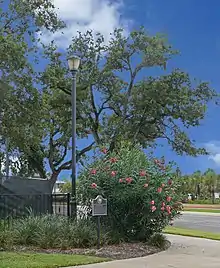 The first oleander planting in Galveston, Texas (1841)
The first oleander planting in Galveston, Texas (1841).jpg.webp) Red flower
Red flower A follicle spreading seeds
A follicle spreading seeds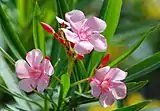 Pink flowers and leaves
Pink flowers and leaves A small bush
A small bush A small tree
A small tree
Other species in tribe Nerieae: Oleander's closest relatives within Apocynaceae
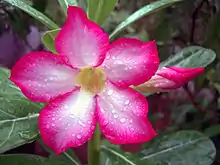 Adenium obesum (syn. Nerium obesum) single flower
Adenium obesum (syn. Nerium obesum) single flower%252C_Ghana.jpg.webp) Adenium obesum colossal specimen, Ghana
Adenium obesum colossal specimen, Ghana.jpg.webp)
_4283.jpg.webp) Strophanthus gratus - note corona like that present in Nerium flower
Strophanthus gratus - note corona like that present in Nerium flower
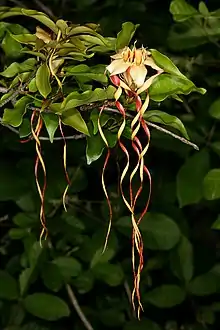 Strophanthus petersianus: flowers, showing streamer-like corolla lobes
Strophanthus petersianus: flowers, showing streamer-like corolla lobes Spectacular flowers of Strophanthus speciosus
Spectacular flowers of Strophanthus speciosus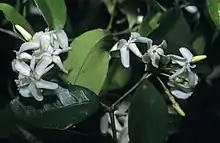 Alafia caudata subsp. latiloba
Alafia caudata subsp. latiloba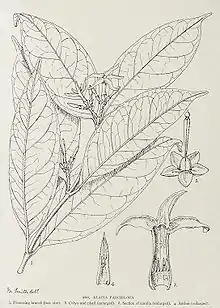 Alafia parciflora
Alafia parciflora
See also
- List of ineffective cancer treatments
- List of plants poisonous to equines
- List of poisonous plants
- Tibesti-Jebel Uweinat montane xeric woodlands
- Yellow oleander
References
- Sunset Books (1995). Sunset Western Garden Book. Sunset Publishing Corporation. pp. 606–607. ISBN 978-0-376-03850-0.
- "Nerium". Atlas of Florida Plants. Retrieved 2017-05-07.
- Pedanius Dioscorides. De Materia Medica. p. V.42.
- "Oleander: Definition of Oleander". Merriam-Webster Dictionary. Retrieved 2017-06-25.
- "Oleander (n.)". Online Etymology Dictionary. Retrieved 2017-06-25.
- Wilhelmina Feemster Jashemski; Frederick G. Meyer (19 September 2002). The Natural History of Pompeii. Cambridge University Press. p. 133. ISBN 978-0-521-80054-9.
- "French translation of 'oleander'". Collinsdictionary.com. Retrieved 2017-12-29.
- "adelfa". Diccionario de le lengua española. Retrieved 2017-12-29.
- "Archaeological Site of Volubilis". African World Heritage Fund. Archived from the original on 2013-10-20. Retrieved 2013-05-12.
- Schmelzer, G.H.; A. Gurib-Fakim (2008). Medicinal Plants. Plant Resources of Tropical Africa. pp. 43–49. ISBN 978-90-5782-204-9.
- "World Checklist of Selected Plant Families, entry for Nerium oleander". Retrieved May 18, 2014.
- "World Checklist of Selected Plant Families, entry for Nerium". Retrieved May 18, 2014.
- Pankhurst, R. (editor). Nerium oleander L. Flora Europaea. Royal Botanic Garden Edinburgh. Retrieved on 2009-07-27.
- Bingtao Li, Antony J. M. Leeuwenberg, and D. J. Middleton. "Nerium oleander L.", Flora of China. Harvard University. Retrieved on 2009-07-27.
- INCHEM (2005). Nerium oleander L. (PIM 366). International Programme on Chemical Safety: INCHEM. Retrieved on 2009-07-27
- Huxley, A.; Griffiths, M.; Levy, M. (eds.) (1992). The New RHS Dictionary of Gardening. Macmillan. ISBN 0-333-47494-5.
- Tony Bizjak (2015-04-09). "Will freeway oleander survive the drought?". The Sacramento Bee. Retrieved 2017-05-14.
- Ron Hamilton (2009-02-05). "Oleanders are Dying in San Diego". sandiegoreader.com. Retrieved 2017-08-19.
- "History - International Oleander Society". oleander.org. Archived from the original on 2017-07-08. Retrieved 2016-04-10.
- "Moody Gardens & the IOS". International Oleander Society. Retrieved 2019-04-15.
- Alain Delavie (2016-08-07). "Paris côté jardin Archives de mots clés Laurier Rose". Retrieved 2017-07-21.
- "Oleander". RHS Gardening. Retrieved 2017-06-10.
- Helen Yemm (2008-09-19). "Gardening Advice: Thorny problems". The Daily Telegraph. Retrieved 2017-06-10.
- Marc Mennessier (2014-11-24). "Jardin: Prolongez vous vos vacances en plantant in laurier-rose". Le Figaro. Retrieved 2018-02-25.
- Loree Bohl (2013-07-22). "Hey check out that parking lot!". Thedangergarden.com. Retrieved 2018-02-24.
- Herrera, Javier (1991). "The reproductive biology of a riparian Mediterranean shrub, Nerium oleander L. (Apocynaceae)". Botanical Journal of the Linnean Society. 106 (2): 147–72. doi:10.1111/j.1095-8339.1991.tb02289.x.
- Shmida, A., Ivri, Y., and Cohen, D. The enigma of the oleander. Eretz VeTeva, January–February 1995 (in Hebrew).
- "Oleander Leaf Scorch". University of California Agriculture & Natural Resources. April 2008. Retrieved 2017-05-14.
- U.C. Master Gardeners (1998-11-21). "How to Battle Oleander Leaf Scorch". Los Angeles Times. Retrieved 2017-05-14.
- Kathleen Norris Brenzel (2007). Sunset Western Garden Book. p. 495.
- Laura Murphy (2007-09-27). "Oleanders under attack" (PDF). UA College of Agricultural & Life Sciences. Retrieved 2017-05-14.
- "Oleander Culture". International Oleander Society. Retrieved 2018-03-26.
- Elvin McDonald (1987-04-27). "Shedding Light on Growing Oleanders Indoors". Chicago Tribune. Retrieved 2018-03-26.
- "Blooming Oleanders of the American Collection". Oleanderhaus.com.
- Linda French (1989-07-01). "Gardening : Nerium oleander : Petite oleanders: Evergreen drought-tolerant dwarf shrubs with showy flowers". Los Angeles Times. Retrieved 2017-05-14.
- Szabuniewicz, M; Schwartz, WL; McCrady, JD; Camp, BJ (1972). "Experimental oleander poisoning and treatment". Southwestern Veterinarian. 25 (2): 105–14.
- Szabuniewicz, M; McCrady, J. D; Camp, B. J (1971). "Treatment of experimentally induced oleander poisoning". Archives Internationales de Pharmacodynamie et de Therapie. 189 (1): 12–21. PMID 5167071.
- Hougen, T. J; Lloyd, B. L; Smith, T. W (1979). "Effects of inotropic and arrhythmogenic digoxin doses and of digoxin-specific antibody on myocardial monovalent cation transport in the dog". Circulation Research. 44 (1): 23–31. doi:10.1161/01.res.44.1.23. PMID 758230.
- Langford, Shannon D; Boor, Paul J (1996). "Oleander toxicity: An examination of human and animal toxic exposures". Toxicology. 109 (1): 1–13. doi:10.1016/0300-483X(95)03296-R. PMID 8619248.
- Associate Press (2000-07-25). "Oleander Poisoning Kills 2 Kids". apnews.com. Retrieved 2018-07-01.
- Jessica Garrison (2000-07-26). "2 Toddlers Died from Oleander Poisoning, Coroner Says". Los Angeles Times. Retrieved 2018-06-28.
- Goetz, Rebecca. J. (1998). "Oleander". Indiana Plants Poisonous to Livestock and Pets. Cooperative Extension Service, Purdue University. Archived from the original on 2010-02-23. Retrieved 2009-07-27.
- Pao‐Franco, Amaris; Hammond, Tara N.; Weatherton, Linda K.; DeClementi, Camille; Forney, Scott D. (29 July 2017). "Successful use of digoxin‐specific immune Fab in the treatment of severe Nerium oleander toxicosis in a dog". Journal of Vererinary Emergency and Critical Care. 27 (5): 596–604. doi:10.1111/vec.12634. PMID 28755414.
- Knight, A. P. (1999). "Guide to Poisonous Plants: Oleander". Colorado State University. Retrieved 2009-07-27.
- Trevino, Monica (2009). "Dozens of horses poisoned at California farm". CNN. Retrieved 2009-08-03.
- Henary, H. A; Kurzrock, R; Falchook, G. S; Naing, A; Moulder, S. L; Wheler, J. J; Tsimberidou, A. M; Durand, J; Yang, P; Johansen, M. J; Newman, R; Khan, R; Patel, U; Hong, D. S (2011). "Final results of a first-in-human phase I trial of PBI-05204, an inhibitor of AKT, FGF-2, NF-Kb, and p70S6K in advanced cancer patients". Journal of Clinical Oncology. 29 (15_suppl): 3023. doi:10.1200/jco.2011.29.15_suppl.3023.
- Newman, R. A; Yang, P; Pawlus, A. D; Block, K. I (2008). "Cardiac Glycosides as Novel Cancer Therapeutic Agents". Molecular Interventions. 8 (1): 36–49. doi:10.1124/mi.8.1.8. PMID 18332483.
- "Oleander Leaf". American Cancer Society. Archived from the original on 2013-03-15. Retrieved 2018-03-26.
- Ecclesiasticus XXXIV, 13.
- John McClintock (1880). Cyclopaedia of Biblical, Theological, and Ecclesiastical Literature. p. 129–130.
- Martha Modzelevich. "Plants of the Bible: Oleander". flowersinisrael.com. Retrieved 2018-06-12.
- Pliny. Natural History. p. 24.90.
- Pedanius Dioscorides. De Materia Medica. p. V.42.
- Haralampos Harissis. "A Bittersweet Story: The True Nature of the Laurel of the Oracle of Delphi". Perspectives in Biology and Medicine. p. 351-60.
- Theophrastus. Inquiry into Plants. Translated by A. F. Hort. Loeb Classical Library. pp. I.9.3, IX.19.1.
- Farrar, Linda (2002). Ancient Roman Gardens. Budding Books. pp. 141–2, 143–9. ISBN 978-1-84015-190-9.
- Mikkelson, Barbara (2011-07-31). "Oleander Poisoning: snopes.com". Snopes.com. Retrieved 2015-11-29.
- Thomas C. Fuller; Elizabeth May McClintock (1 January 1986). Poisonous Plants of California. University of California Press. p. 78. ISBN 978-0-520-05569-8.
- Pliny. Natural History. p. 21.77.
- William John Hamilton (1984). Researches in Asia Minor, Pontus and Armenia. Georg Olms Verlag. p. 160. ISBN 978-3-487-41321-1.
- William John Hamilton (1842). Researches in Asia Minor, Pontus, and Armenia,: With Some Account of Their Antiquities and Geology [in 1836]. John Murray. p. 384.
- Bryce, Emma (2014-09-04). "The Strange History of 'Mad Honey'". Modern Farmer. Retrieved 2019-08-09.
- "Gustav Klimt, Two Girls With An Oleander". Wadsworth Atheneum Museum of Art.
- "Oleanders". The Metropolitan Museum of Art. Retrieved 2017-06-08.
- Russell Ash (1992). Sir Lawrence Alma-Tadema. Harry Abrams.
- "The Terrace at Méric (Oleanders)". wikiart.org. Retrieved 2018-06-08.
- "Fuliva with Cicero's Head". the-athenaeum.org. Retrieved 2018-07-02.
- "White Oleander". Oprah.com. 1999-05-06. Retrieved 2017-06-08.
- Miramax Films (2017-03-21). Enchanted April (1992) - Clip 13. YouTube.com. Retrieved 2018-05-08.
- Parvati Sharma (2018-11-09). "The emperor of oleander blossoms". Hindustan Times. Retrieved 2019-04-23.
- Cather, Willa (1915). "IV". The Song of the Lark. Project Gutenberg. p. 26.
- Tredici, PD; Tsuchida, H (1993). "Hibaku trees of Hiroshima" (PDF). Arnoldia: 27.
Notes
- Cf. oleaster
- The "Yellow Oleander" is Thevetia peruviana
- In the past, scented plants were sometimes treated as the distinct species N. odorum, but the character is not constant and it is no longer regarded as a separate taxon.
External links
| Wikimedia Commons has media related to Nerium. |
| Wikispecies has information related to Nerium. |
- Clemson University: Oleander Facts. Retrieved on 2018-03-26.
- International Oleander Society: Information on Oleander toxicity. Retrieved on 2009-07-27.
- Barcelona Botanic Gardens: Plants of North Africa. Retrieved on 2009-07-27.
- Erwin, Van den Enden. 2004. Illustrated Lecture Notes on Tropical Medicine. Medical problems caused by plants: Plant Toxins, Cardiac Glycosides. Prince Leopold Institute of Tropical Medicine. Retrieved on 2009-07-27.
- Desai, Umesh R. Cardiac glycosides. Virginia Commonwealth University. School of Pharmacy. Retrieved on 2009-07-27.
- Snopes: Legend of Oleander-poisoning at Campfire. Retrieved on 2009-07-27.
- Distribution over the world, University of Helsinki
